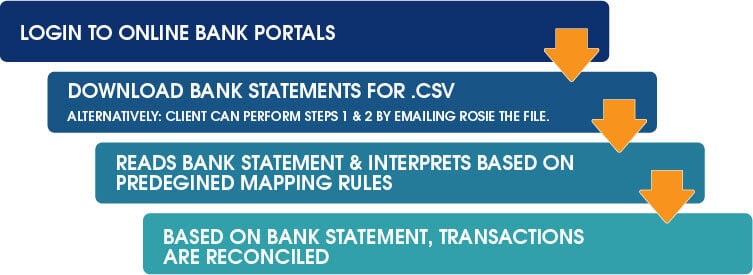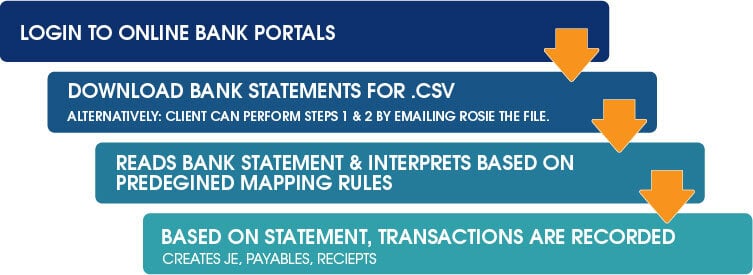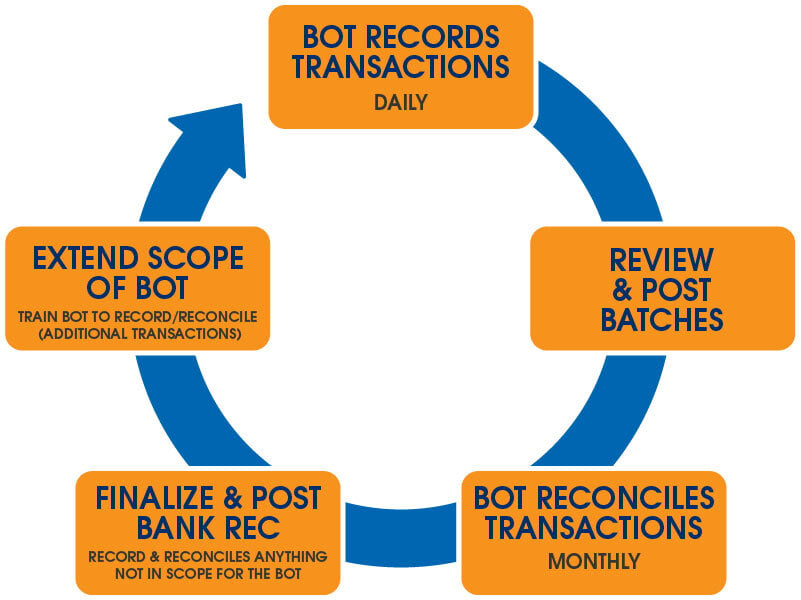Automation in Real Estate

Real estate automation has seen widespread adoption among our clients in recent years. REdirect’s real estate automation experts are helping property management organizations to free up resources, streamline their operations, and save countless hours by creating automations that fit their individual requirements exactly.
Our real estate automation experts bring thousands of hours of collective experience in creating automations that significantly improve ROI. At our core, we are Yardi and MRI consultants, and therefore we often look to optimize the use of these ERP tools’ built-in features before developing something new.
The latest developments in RE automation technology are pushing the boundaries of what was previously possible. In this post, we will discuss some of the most common use cases that have been refined and repeated across multiple organizations.
Bank Recs

Our bank rec bot is among the most widely requested automation that we have implemented for our clients.
Real estate businesses often have high numbers of different bank accounts. Each property typically has an operating account, a security deposit (SD) account, and potentially other accounts too. For our clients that manage multiple properties, the sheer number of required bank recs each month can add up to a significant administrative burden.
The bank rec bot uses a simple three-step process. It first obtains the bank data, which can be done in several ways. In an ideal world, the bank will send the file to the bot directly. This is very achievable when working with large national banks, but it often takes a few weeks to coordinate and go live with the transmission. Alternative options are for the bot to log into the banking system and download the file itself, or for the client to download the file and send it to the bot manually.
Our real estate experts work closely with clients during the implementation of the bot, training the bot in how to read the data and what to look out for. We have extensive experience in this industry but every client is unique, so investing the time to understand each client’s most frequently recurring transactions allows us to achieve the highest match rate with our tool.
After the bot has obtained the file and read it, it gets to work checking off the boxes on the bank rec screen and marking each transaction as reconciled.
Finally, an Excel-based deliverable is created by the bot. This allows us to trace exactly which transactions are reconciled and what remains to be reconciled.
Bank to Book

Our bank to book automation works very similarly to the bank rec bot in the first two stages of obtaining and reading the data. However, bots that record transactions typically run daily, while the bank rec bot runs monthly.
By training the bank to book bot to record transactions, we typically leave those transactions unposted. This allows the accounting users to review posts and offers a greater degree of internal control. Some of the most common transactions we have had our bots record include:
- Interest earned
- Bank fees
- Mortgage payments
- Cash receipts from tenants
- Auto debited payables
Putting It All Together

Pairing the bank rec bot and the daily bank to book bot creates a cycle of continuous improvement for the client, as illustrated above.
Each month, the bots can be further trained to record and reconcile more items. This limits the administrative burden on our client’s staff and increases the scope of the bot. And since these machine learning tools are not susceptible to human error, our clients can also enjoy higher levels of accuracy in their reconciliations and accounting.
Reporting
Reporting is another area of real estate automation in which we are seeing widespread adoption. Without automation, our clients often find that they have to download multiple reports, review them, combine them into one PDF with a cover page, and distribute them manually.
This process is not only highly time-consuming, but it is also at risk from human error. Automating the reporting process ensures consistency and accuracy while freeing up staff time to do tasks that cannot be handed off to a machine.
Automated reports are highly customizable. Clients can choose the frequency of reports, precisely which data is included, and the format in which they would like the data to be presented.
While we often try to use the built-in reporting functionality of enterprise resource planning (ERP) tools like Yardi and MRI, we often find that reports from various sources need to be collated together. For example, some owners want their bank statements included with their financial package. Our bots can gather these various components, package them together with a table of contents, and email them out to each stakeholder. Our bots can also perform data validation checks, ensuring that the various reports are reconciled before sending them out.
Accounts Payable
Accounts payable (AP) is another ripe area for automation. Bots can be configured to scrape relevant data from invoices and key the correct figures into the AP modules of Yardi or MRI.
Automating AP processes ensures that all invoices are paid on time. This keeps clients and suppliers happy and ensures that users are never hit with avoidable late payment fees. Automating AP also assists with a business’s cash flow by ensuring that all payments are going out precisely when they should be. With improved visibility, clients always know exactly what is happening with their finances at any given moment.
Automation makes AP processes far faster and more efficient and, again, removes the possibility of human error.
Taxes
Taxes can be complicated, and that is never more true than in the world of real estate. Often, clients who own properties must navigate county websites to obtain their tax bills and key the figures into the AP modules of Yardi or MRI.
This is a great area to outsource to a bot. Data entry is a monotonous, laborious process and can be carried out much faster and more accurately by a machine than by a person. This will ensure that your taxes are always up to date so that you can avoid any problems that can crop up as a result of incomplete or incorrect tax payments.
Conclusion
As you can see, numerous areas of running a real estate business are perfect for automation. Handing over repetitive, monotonous tasks to bots frees up your staff to do the parts of their work that cannot be done by a machine. It improves accuracy, reduces errors, and gives you a better picture of how your business is performing.
Our Yardi and MRI consultants are ideally placed to help you integrate and make use of the appropriate automation tools for your business.
If you would like to learn more about how we can work together or if you’re ready to get started, drop us a line. A member of our team will be in touch. We are looking forward to showing you how real estate automations can transform your business for the better.
